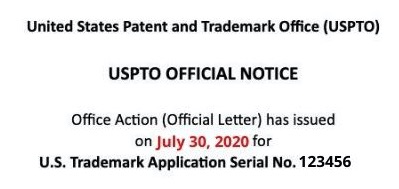Here’s the scene: you file an application to register a trademark with the United States Patent and Trademark Office and eagerly await a favorable response. A few months go by. “What are they doing over there? Don’t they know my trademark is a top priority?”
Finally, you get an email from the USPTO. The header looks like this:

You open up the email and scan down to where it reads “Registration of the applied-for mark is refused because…”
This document is called an Office Action. It’s not great news, but don’t panic. In many cases, there is a way to respond to the Office Action that will cause the USPTO to register your trademark.
The first thing to know is that you have six months from the date of the Office Action to respond. If you don’t respond by that deadline, your application will be abandoned.
Another important point is that in most cases, the first Office Action you’ll receive is called a “Nonfinal Office Action”. If you respond to the Nonfinal Office Action, but your response isn’t satisfactory, you’ll receive, you guessed it, a “Final Office Action”. At that point you once again have six months to respond. So you get, in a sense, two bites at the apple. There are other ways to respond to a Final Office Action, such as filing a Request for Reconsideration or appealing the matter to the Trademark Trial and Appeal Board, but those are outside the scope of this blog post.
How to Respond to an Office Action
There are many reasons why a trademark application may receive an Office Action. Some are very simple and can be resolved with an email or a quick phone call to the USPTO Examining Attorney, whose name and contact information appears at the bottom of the Office Action.
For example, the Examining Attorney may simply be requesting that you enter a disclaimer. If your trademark application is for ABRACADABRA PIZZA for a chain of pizza restaurants, you may have to state that you are not claiming exclusive rights to the word “pizza” outside of the context of your trademark. This is often (but not always) a noncontroversial request.
For more complex matters, formal Responses to Office Actions are filed through the USPTO website using the Response to Examining Attorney Office Action Form on this page.
Two of the most common types of trademark rejections that require more substantial responses are rejections based on “likelihood of confusion” with one or more prior trademark filings (these are referred to as §2(d) refusals) and those that claim the mark is “merely descriptive” of the goods and services, or a feature of the goods and services (these are §2(e)(1) refusals).
Likelihood of confusion rejections are based on the principle that a mark cannot be registered when it is likely to be confused with a prior mark. These rejections often can be overcome, but convincing the Examining Attorney to remove this objection requires an response that considers at least some of the thirteen factors identified in the case In re E.I. du Pont de Nemours & Co. (the du Pont factors).
Descriptiveness rejections also can sometimes be overcome. To do so, you will have to show either that the mark is “inherently distinctive” or that it has “acquired distinctiveness”. Alternatively, marks that are “merely descriptive” may be eligible for placement on the USPTO’s Supplemental Register of Trademarks, which provides a more limited set of rights.
Should you receive an Office Action that relates to complex issues, it’s usually best to bring in an experienced trademark attorney who has successfully resolved these issues in the past. If you’ve received an Office Action from the United States Patent and Trademark Office and you want to discuss your options, please feel free to contact me.


